Washington Island (Wisconsin)
Washington Island is an island of the state of Wisconsin situated in Lake Michigan. Lying about 7 miles (11 km) northeast of the tip of the Door Peninsula, it is part of Door County, Wisconsin.[1] The island has a year-round population of 708 people according to the 2010 census. It has a land area of 60.89 km² (23.51 sq mi) and comprises over 92 percent of the land area of the town of Washington, as well as all of its population. The unincorporated community of Detroit Harbor is situated on the island. It is the largest in a group of islands that includes Plum, Detroit, Hog, Pilot, Fish, and Rock Islands. These islands form the Town of Washington. Detroit Harbor bay is on the south side of the island. A large part of Washington Island's economy is based on tourism.[2]
 Washington Island  Washington Island | |
| Geography | |
|---|---|
| Location | Door County, Wisconsin |
| Coordinates | 45°22′37″N 86°53′47″W |
| Area | 23.51 sq mi (60.9 km2) |
| Length | 6 mi (10 km) |
| Width | 5 mi (8 km) |
| Administration | |
United States | |
| Demographics | |
| Population | 708 (2010) |
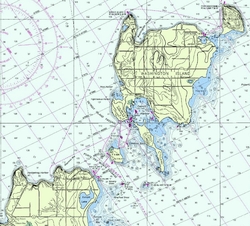
Washington Island is approximately 5 miles (8 km) wide by 6 miles (10 km) long. Together with the Door Peninsula, Washington Island forms a treacherous strait that connects Green Bay to the rest of Lake Michigan. Early French explorers named this water way, now littered with shipwrecks, Porte des Morts, which literally means "Door of the Dead" or, more colloquially, "Death's Door", giving both Door County and Door Peninsula their names.[3]
History
Washington Island is one of a string of islands (which are an outcropping of the Niagara Escarpment) stretching across the entrance of Green Bay from the Door Peninsula in Wisconsin to the Garden Peninsula in Michigan. Its earliest known name is "Wassekiganeso," an Ojibwa name that translates to "his breast is shining" and apparently refers to the glint of the sun that at times reflects off the limestone cliffs.[4]
The earliest records and maps of the French, with whom written history of the region begins, do not name the individual islands, but refer to them all as a group. The names chosen depended on which group of Native Americans they found on the islands at the time. The most common name from after 1650 to 1816 was the Potawatomi Islands.[5] The Potawatomi appear to have first come to especially the southern islands in the string about 1641 (at which time they may figure into the naming of Porte des Morts), then left the area for a while, and then returned again and remained there for a considerable length of time. The French form of this name (also variously spelled) is l'Isle des Poux, based on a shortened form of the tribe's name. This shortened form also appears as "Pous" and is at times erroneously confused with Puans, which refers to the Winnebago. At times the French used the latter portion of the tribe's name, "Pou_a louse", resulting in Louse Islands.
Before 1800, however, a few other names were applied to these islands. The Jesuit Records of 1670-1672 refer to them as the Huron Islands. Other records of the time refer to them as the Noquet Islands, named for the small band of Ojibwa that lived in the area of what is now called Big Bay de Noc, as well as, for a time, on Washington Island.[6] Jonathan Carver, who traveled the area in the late 18th century, called them, simply, the Islands of the Grand Traverse.[7]
In July 1816, Col. John Miller garrisoned a new fort at the head of Green Bay to be called Fort Howard. Three schooners and one sloop sailed from Mackinac. They were the sloop Amelia and the schooners Wayne, Mink, and Washington, the last being the largest and flagship of the fleet, as well as, reportedly, the largest vessel on the lakes at the time.[8] The fleet was separated en route, and the Washington anchored in what is now Washington Harbor to wait for the others. With two days of waiting, some of the crew explored the island, and the officers, assuming theirs was the first ship to anchor there, named the harbor after the ship and in honor of President Washington. They also named various islands in the area after significant members of their party, with the name of Col. John Miller being honored on the largest island as Millers Island. Other members of the party included Maj. Talbot Chambers, John O'Fallon, and Joseph Kean. Chambers Island retains its name today, while Keans Island and Fallons Island are now called Rock and Detroit Islands, respectively.[9]

Not every map maker or journalist, however, knew of or paid attention to this. The names of Potawatomi and Louse continued to be used by many for many years, with a continued variety of spellings. At times Potawatomi was applied to the main island; sometimes to what is now Rock Island. At times the main island was missing from the map. When the lighthouse was built on Rock Island, it was called Pottawatomie Light, the name it has retained. While a few maps did chart either [?]ellens or Mellens Island (a possible corruption of Miller), the settlement of the island began with the fishers and craftsmen living around Washington Harbor. A large non-Native American presence did not begin until the 1830s, when settlers on their way to Green Bay heard of large sized trout. Most of these settlers were Icelandic and Irish.[10] These settlers commonly called the whole island by the name of their harbor and in the census of 1850, "Washington Island" appeared.[11] After that, both Potawatomi Islands, and Potawatomi Island soon fell out of use.
The border between Wisconsin and Michigan was originally defined as "the most usual ship channel" into Green Bay from Lake Michigan but commercial routes existed both to the north and south of the island which led to a border dispute. In 1936, the U.S. Supreme Court decision Wisconsin v. Michigan found that Washington and three other islands were part of Wisconsin.
Culture
A majority of the people who settled on the island were Scandinavian immigrants, especially Icelanders. Today, Washington Island is one of the oldest Icelandic communities in the United States and among the largest outside Iceland itself.[3] Because of a loophole exploited during Prohibition by the owner of Nelsen's Hall (one of the few bars on the island at the time), taking shots of Angostura Bitters is a local tradition. Washington Island's population consumes more bitters than anyone else in the world.[12]
Modern day
Washington Island hosts the Midwest region's largest lavender farm,[13] accompanied by a biennial festival held in summer.[14] Three parks and two beaches [15] dot the island. A fine arts school, the Sievers School of Fiber Arts, also calls the island home.[16]
Climate
Washington Island has a humid continental climate influenced to some degree by its offshore position in Lake Michigan. This results in summer temperatures being moderated, seasonal lag being prevalent and winters being less cold than in western Wisconsin on the same latitude.
| Climate data for Washington Island | |||||||||||||
|---|---|---|---|---|---|---|---|---|---|---|---|---|---|
| Month | Jan | Feb | Mar | Apr | May | Jun | Jul | Aug | Sep | Oct | Nov | Dec | Year |
| Record high °F (°C) | 48.9 (9.4) |
52.0 (11.1) |
71.1 (21.7) |
77.0 (25.0) |
87.1 (30.6) |
91.9 (33.3) |
93.9 (34.4) |
98.1 (36.7) |
93.9 (34.4) |
84.0 (28.9) |
71.1 (21.7) |
57.9 (14.4) |
98.1 (36.7) |
| Average high °F (°C) | 25.9 (−3.4) |
28 (−2) |
36.9 (2.7) |
48.7 (9.3) |
59.9 (15.5) |
69.6 (20.9) |
76.3 (24.6) |
75.4 (24.1) |
67.3 (19.6) |
55.8 (13.2) |
42.6 (5.9) |
31.1 (−0.5) |
51.5 (10.8) |
| Daily mean °F (°C) | 18.7 (−7.4) |
20.1 (−6.6) |
28.8 (−1.8) |
39.9 (4.4) |
50.0 (10.0) |
59.9 (15.5) |
66.7 (19.3) |
66.4 (19.1) |
58.8 (14.9) |
48.4 (9.1) |
36.3 (2.4) |
25.2 (−3.8) |
43.3 (6.3) |
| Average low °F (°C) | 11.1 (−11.6) |
11.8 (−11.2) |
20.5 (−6.4) |
31.1 (−0.5) |
40.1 (4.5) |
50.2 (10.1) |
57.0 (13.9) |
57.2 (14.0) |
50.4 (10.2) |
40.8 (4.9) |
30.4 (−0.9) |
19.2 (−7.1) |
35.0 (1.7) |
| Record low °F (°C) | −27.0 (−32.8) |
−26.0 (−32.2) |
−26.0 (−32.2) |
1.9 (−16.7) |
19.9 (−6.7) |
24.1 (−4.4) |
35.1 (1.7) |
32.0 (0.0) |
26.1 (−3.3) |
18.0 (−7.8) |
1.0 (−17.2) |
−20.9 (−29.4) |
−27.0 (−32.8) |
| Average precipitation inches (mm) | 1.4 (36) |
0.9 (24) |
1.6 (40) |
2.4 (61) |
3.0 (75) |
3.2 (81) |
3.1 (78) |
3.2 (82) |
3.2 (82) |
2.6 (67) |
2.3 (59) |
1.5 (37) |
28.4 (721) |
| Average snowfall inches (cm) | 13.2 (33.5) |
9.6 (24.4) |
8.0 (20.3) |
2.8 (7.1) |
0.2 (0.5) |
0.0 (0.0) |
0.0 (0.0) |
0.0 (0.0) |
0.0 (0.0) |
0.1 (0.2) |
3.0 (7.6) |
10.5 (26.7) |
47.4 (120.4) |
| Average precipitation days | 7.7 | 5.5 | 6.5 | 8.3 | 9.0 | 9.2 | 8.9 | 9.0 | 9.6 | 8.2 | 9.1 | 8.2 | 99.3 |
| Source: Weatherbase [17] | |||||||||||||
| ||||||||||||||||||||||||||||||||||||||||||||||||||||||||||||||||||||||||||||||||||||||||||||||||||||||||||||||||||||||||||||
Transportation
Washington Island is served by two ferry routes. The first route is to take a 30-minute ferry ride from the Door Peninsula to Detroit Harbor on the island from a freight, automobile, and passenger ferry that departs daily from the Northport Pier at the northern terminus of Wisconsin Highway 42. The second route is a passenger-only ferry that departs from the unincorporated community of Gills Rock on a 20-minute route, which includes an optional bundled narrated train tour upon arriving on Washington Island.[19]
The Washington Island Airport, a small public airport with two grass runways, is located on the island.[20]
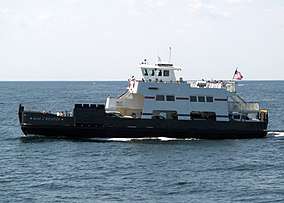 Arni J. Richter car ferry
Arni J. Richter car ferry Eyrarbakki car ferry.
Eyrarbakki car ferry.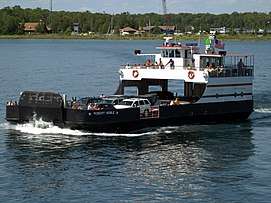 Robert Noble car ferry
Robert Noble car ferry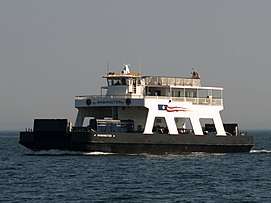 Washington car ferry
Washington car ferry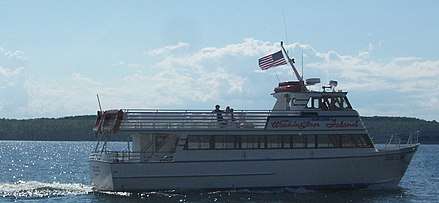 Island Clipper passenger ferry
Island Clipper passenger ferry
Gallery
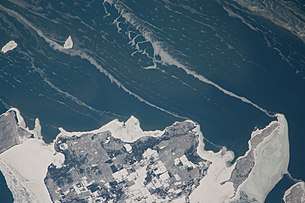 From the ISS, February 2014
From the ISS, February 2014 Coast Guard helicopter, following an emergency landing in March 2014
Coast Guard helicopter, following an emergency landing in March 2014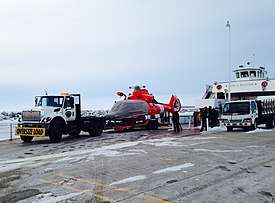 Helicopter loaded onto a truck, 2014
Helicopter loaded onto a truck, 2014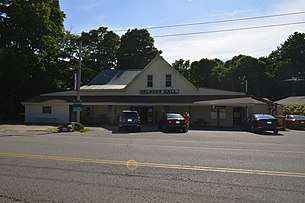 Nelsen's Hall
Nelsen's Hall Building at Sand Dunes Park
Building at Sand Dunes Park Performing Arts Center
Performing Arts Center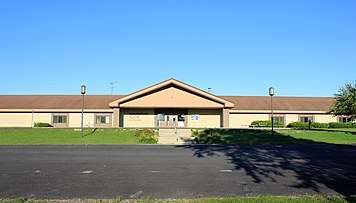 School
School Lavender in July
Lavender in July Fall color, October 20
Fall color, October 20
See also
- Coffee Swamp
- Populated islands of the Great Lakes
- List of islands of the United States
- Washington Island Stavkirke
References
- "Washington Island (Wisconsin)". Geographic Names Information System. United States Geological Survey.
- "Washington Island". washingtonisland.com. Retrieved 2018-06-26.
- "Washington Island: History & Culture".
- Eaton, Conan Bryant, The Naming: A Part of the History of Washington Island, Printed by the Door County Advocate, Sturgeon Bay, WI, 1966, page 1
- "A Brief Island History". washingtonisland.com. Retrieved 2018-06-26.
- Noquet Indian Tribe
- Eaton, C.B, p. 4
- Eaton, C.B., p.7
- Eaton, C.B., pp. 14-15
- Moon Spotlight Wisconsin's Door County By Thomas Huhti
- Eaton, C.B., p. 16
- Kunkel, Leigh (2018-03-05). "How a Tiny Wisconsin Island Became the World's Biggest Consumer of Bitters". Atlas Obscura. Retrieved 2018-08-10.
- "The Largest Lavender Farm In The Midwest Calls Washington Island Home | Wisconsin Life". www.wisconsinlife.org. Retrieved 2018-06-26.
- "2018 Fragrant Isle "All Things Lavender" Festival Announcement". Fragrant Isle Lavender Farm & Shop. Retrieved 2018-06-26.
- "Beaches & Parks". washingtonisland.com. Retrieved 2018-06-26.
- "Sievers School of Fiber Arts — Learn, refresh and reflect". sieversschool.com. Retrieved 2018-06-26.
- "Weatherbase: Historical Weather for Washington Island, Wisconsin". Weatherbase. Retrieved 2012-07-26.
- "NASA Earth Observations Data Set Index". NASA. Retrieved 30 January 2016.
- "The Island Clipper & The Viking Train". www.islandclipper.com. Retrieved 2018-06-26.
- "By Airplane". washingtonisland.com. Retrieved 2018-06-26.
Bibliography
External links
- Washington Island Chamber of Commerce
- WashingtonIsland.com
- Door County Chamber of Commerce
- Washington Island Ferry Line Departing from Northport Pier
- The Island Clipper Departing from Gills Rock
- Washington Island Airport Information
